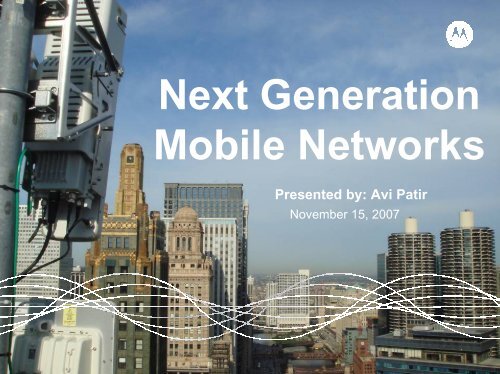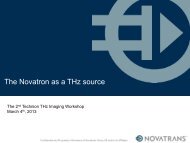Next Generation Mobile Network - WorkShop
Next Generation Mobile Network - WorkShop
Next Generation Mobile Network - WorkShop
Create successful ePaper yourself
Turn your PDF publications into a flip-book with our unique Google optimized e-Paper software.
<strong>Next</strong> <strong>Generation</strong><br />
<strong>Mobile</strong> <strong>Network</strong>s<br />
Presented by: Avi Patir<br />
November 15, 2007
The Expansion of Broadband
Growth in Broadband<br />
18% average annual growth (2006-2010)<br />
» Broadband penetration in<br />
Europe is currently 25% with a<br />
Y/Y growth of 43% over the<br />
past two years<br />
» In Asia Pacific, broadband<br />
infiltration is only 11%, but Y/Y<br />
growth is 58%<br />
Active subscriptions (million)<br />
Worldwide Broadband Subscriber Growth<br />
500<br />
50%<br />
416<br />
400<br />
350<br />
40%<br />
299<br />
300 258<br />
30%<br />
218<br />
200 22%<br />
20%<br />
18%<br />
19%<br />
16%<br />
17%<br />
100<br />
10%<br />
0<br />
2006 2007 2008 2009 2010<br />
Total BB Subscribers<br />
%YoY Growth<br />
0%<br />
Source: Motorola and Infonetics, May 2006
I Am Stuck At Home
I Want My Stuff To Go With Me
Multi Media <strong>Mobile</strong> Device<br />
WWAN VoIP WWAN VoIP WWAN VoIP<br />
Bluetooth TM WWAN Data WWAN Data<br />
WWAN VoIP<br />
WWAN Data<br />
WWAN VoIP<br />
WWAN Data<br />
Bluetooth TM<br />
GPS<br />
MediaFLO<br />
Wi-Fi<br />
Bluetooth TM<br />
Bluetooth TM<br />
Voice call to<br />
sales manager<br />
While on call,<br />
checks email and<br />
downloads<br />
presentation with<br />
latest sales figures<br />
Checks location<br />
and directions to<br />
client’s office<br />
Watches game on<br />
MediaFLO and has<br />
a group chat with<br />
friends<br />
At home, playing<br />
multiplayer 3D<br />
game, using Wi-Fi<br />
to send video to<br />
nearby display
Rise of Wireless Broadband<br />
Wireless broadband will liberate our connections<br />
Making them wireless and making them mobile<br />
• Globally, mobile surpassed<br />
fixed lines in 2002<br />
• By 2003 mobile had attained<br />
near 40% of telecom service<br />
revenues<br />
Worldwide Broadband Subscriber Forecast<br />
Wireline vs. Wireless<br />
Wireline Broadband<br />
Wireless Broadband<br />
• <strong>Mobile</strong> data revenues are<br />
projected to experience a 20%<br />
CAGR with significant portion<br />
of revenues from mobile<br />
access to information and<br />
entertainment<br />
5M<br />
2%<br />
213M<br />
98%<br />
2006<br />
343M<br />
82%<br />
2010<br />
73M<br />
18%<br />
Source: Motorola and Infonetics, May 2006
Future <strong>Mobile</strong> <strong>Network</strong><br />
Characteristics
4G <strong>Mobile</strong> <strong>Network</strong>s<br />
A spectrally efficient system (in bits/s/Hz and bit/s/Hz/site)<br />
High network capacity: more simultaneous users per cell<br />
A nominal data rate of 100 Mbit/s while the client<br />
physically moves at high speeds (>100 Km/h) relative to<br />
the station, and 1 Gbit/s while client and station are in<br />
relatively fixed positions<br />
A data rate of at least 100 Mbit/s between any two points<br />
in the world<br />
Smooth handoff across heterogeneous networks<br />
Seamless connectivity and global roaming across multiple<br />
networks<br />
High quality of service for next generation multimedia<br />
support (real time audio, high speed data, HDTV video<br />
content, mobile TV, etc)<br />
Interoperability with existing wireless standards, and<br />
An all IP, packet switched network
Trending Toward Broadband IP-Based Systems<br />
CDMA-3GPP2<br />
ANSI-41 Ckt MSC<br />
WIN HLR<br />
ISUP<br />
cdma2000<br />
Circuit based<br />
Legacy Architecture<br />
1X<br />
802.11b<br />
802.11a/g<br />
MSS/HLR<br />
Packet based<br />
Legacy Architecture<br />
EV-DO<br />
802.16e<br />
EV-DO-A<br />
Packet based<br />
EV-DO-B<br />
Multimedia<br />
IOS V5.0<br />
LMSD<br />
WiMAX<br />
UMB<br />
Voice<br />
Core<br />
Packet<br />
Core<br />
GSM-3GPP<br />
GSM-MAP<br />
CAMEL<br />
ISUP<br />
GSM<br />
CktMSC<br />
HLR<br />
GPRS<br />
EDGE<br />
HSUPA<br />
HSDPA 802.16e<br />
802.11a/g 802.20<br />
WCDMA<br />
DVB<br />
802.11b<br />
Circuit based<br />
Legacy Architecture<br />
MSS/HLR<br />
Packet based<br />
Legacy Architecture<br />
UMTS R5 CS<br />
LTE<br />
Voice<br />
Core<br />
Multi-Mode<br />
<strong>Mobile</strong>s<br />
SIP-<strong>Mobile</strong>s Home Gateways<br />
WiFi <strong>Mobile</strong>s<br />
Now<br />
Time<br />
Terminals
Dynamic Industry Evolution<br />
Today’s wireless technologies<br />
evolving to tomorrow’s next generation platforms<br />
70<br />
Market size by technology<br />
60<br />
$ Billions<br />
50<br />
40<br />
30<br />
20<br />
802.16e / WiMAX<br />
LTE<br />
UMTS<br />
GSM<br />
UMB<br />
CDMA<br />
10<br />
0<br />
2005 2006 2007 2008 2009 2010 2011 2012 2013 2014 2015
Increasing Technology<br />
Leverage<br />
Classic Design<br />
Future<br />
Wireless<br />
Voice<br />
Vertical<br />
Features<br />
Transport<br />
Switch<br />
Radio<br />
Controller<br />
Base<br />
Stations<br />
Wireline<br />
Voice<br />
Vertical<br />
Features<br />
Transport<br />
Class 4<br />
Switching<br />
Class 5<br />
Switching<br />
POTS<br />
Phone<br />
Video<br />
Vertical<br />
Features<br />
Content<br />
Transport<br />
Cable<br />
Box<br />
Analog<br />
TV<br />
Data<br />
Vertical<br />
Features<br />
Content<br />
Transport<br />
Dial-Up<br />
Computer<br />
Wireless/Wireline Voice<br />
Video<br />
Internet Video Access<br />
Entertainment<br />
Applications<br />
VoIP Core<br />
Operator Services<br />
Internet Protocol (IP)<br />
Broadband Connection<br />
Guides / Directories
Broadband Applications
NG <strong>Mobile</strong> <strong>Network</strong>s<br />
Technologies<br />
System Characteristics<br />
• All IP<br />
• Convergence<br />
• E2E QOS<br />
• Seamless Mobility<br />
• Flat <strong>Network</strong><br />
Enabling Technologies<br />
• OFDMA<br />
• MIMO<br />
• Smart Antenna<br />
• <strong>Mobile</strong> IP
<strong>Mobile</strong> WiMAX
The Need For Speed<br />
Data Downloaded (5 MegaBytes)<br />
Typical<br />
Peak Rate<br />
GPRS<br />
EDGE<br />
WCDMA<br />
DSL<br />
Cable<br />
EV/DO-A<br />
HSDPA<br />
80 Kbps<br />
128 Kbps<br />
384 Kbps<br />
1.5 Mbps<br />
3.0 Mbps<br />
3.1 Mbps<br />
3.6 Mbps<br />
WiMAX<br />
0.0 0.5 1.0 1.5 2.0 2.5 3.0 3.5 4.0 4.5 5.0 MB<br />
11 Mbps<br />
* 5 MHz, TDD<br />
SMS<br />
Email Internet<br />
Browsing<br />
Java<br />
Game<br />
Email<br />
Attachment<br />
Music File<br />
Downloads<br />
Video File<br />
Downloads
Standard<br />
IEEE 802.16 is the standard.<br />
WiMAX is the name.<br />
The WiMAX label was introduced by<br />
the WiMAX Forum to promote the 802.16<br />
family of standards<br />
802.16<br />
(2001)<br />
Line-of-Sight (LOS)<br />
10-66 GHz<br />
802.16c<br />
(2002)<br />
802.16a<br />
(2003)<br />
Non-Line-of-Sight (NLOS)<br />
2-11 GHz<br />
802.16d<br />
(Oct 2004)<br />
802.16e<br />
(Dec 2005)
Profiles<br />
Motorola is a board member of the WiMAX Forum<br />
and has participation in every working group<br />
WiMAX Forum specifies profiles for 802.16-2004 and 802.16e<br />
“802.16 Standards<br />
Compliant”<br />
WiMAX Forum<br />
Certified<br />
IEEE<br />
802.16e<br />
Fixed / <strong>Mobile</strong><br />
WiMAX Profiles<br />
(To be finalized in 2H 2006)<br />
128-2048 FFT Scaleable OFDMA<br />
Focus on 2.5, 3.5, 5.8 GHz<br />
IEEE<br />
802.16d<br />
Fixed<br />
WiMAX Profiles<br />
256 FFT OFDM<br />
3.5 GHz with 4 Variations:<br />
FDD: 3.5 MHz, 7.0 MHz Channels<br />
TDD: 3.5 MHz, 7.0 MHz Channels<br />
5.8 GHz: 10 MHz Ch; TDD
Spectrum<br />
Motorola is working with global regulators to drive<br />
frequency allocations and harmonize spectrum<br />
Spectral allocations for wireless broadband vary by region; preliminary<br />
profiles focused on 2.5 GHz, 3.5 GHz & 5.8 GHz<br />
US WCS<br />
2.305 – 2.32 GHz<br />
2.345-2.36 GHz<br />
3.3 – 3.4 GHz 3.6 – 3.8 GHz<br />
WRC<br />
5.47 – 5.725 GHz<br />
MDS<br />
2.5 – 2.69 GHz<br />
2.7 – 2.9 GHz<br />
3.5 GHz Band<br />
3.4 – 3.6 GHz<br />
Low/Mid UNII<br />
Band<br />
5.15 – 5.35 GHz<br />
Upper UNII Band<br />
5.725 – 5.85 GHz<br />
3.3-3.4 GHz India, China<br />
3.5 GHz W. Europe, LAC<br />
3.6-3.85 GHz E. Europe, Canada, LAC<br />
5.725 – 5.850 GHz Russia<br />
2.5 GHz US, Singapore, Malaysia,<br />
Japan<br />
Current WiMAX (Rev D) Profiles<br />
Potential Future WiMAX Profiles
<strong>Mobile</strong> WiMAX<br />
System Characteristics
All IP<br />
All existing IP applications will work over WiMAX networks<br />
Throughput and latency stringent applications (VoIP,<br />
streaming video, gaming, etc.) will work better<br />
Motorola solutions easily fits into an existing wired or wireless<br />
application framework<br />
TODAY: 2G & 3G<br />
PSTN<br />
Internet<br />
FUTURE MODEL<br />
SGSN<br />
MSS<br />
PSTN<br />
Internet<br />
Border Gateway and<br />
Home Agent<br />
IMS<br />
Base Station<br />
Controllers<br />
Operator’s<br />
IP <strong>Network</strong><br />
CAP<br />
Controller<br />
Base Stations<br />
Access Points
Simplified Backhaul <strong>Network</strong><br />
Traditional Wireless<br />
WiMAX<br />
Internet<br />
PSTN<br />
Internet<br />
PDSN or<br />
GGSN/SSGN<br />
MSC<br />
T1s<br />
Base Station<br />
Controller<br />
Simpler<br />
lower-cost<br />
all-IP<br />
RF networks<br />
ASN<br />
Gateway<br />
Base Stations<br />
WiMAX<br />
Access Points
Mesh <strong>Network</strong>ing<br />
(BS)<br />
(Subscriber Station)<br />
(SS)<br />
(SS)<br />
(SS)<br />
(BS)
Light Infrastructure Benefits<br />
Traditional Cellular<br />
Infrastructure<br />
Light Infrastructure<br />
Antennas Separate Modular<br />
Active Elements Many Few<br />
Civil Works Tower Pole/Stand<br />
Cooling A/C Convection/Fans<br />
Cabling Analog Coax Digital<br />
Real Estate Traditional Zero Footprint<br />
Infrastructure Housing Temp Control Building All Outdoor<br />
Power Kilowatts Watts<br />
Backhaul T1s Wireless IP<br />
Installation Tools Heavy Equipment Hand Tools
Seamless Mobility
<strong>Mobile</strong> WiMAX<br />
Enabling Technologies
OFDM Basics
Why the Focus on OFDM<br />
The OFDM signal is able to support NLOS<br />
performance while maintaining a high level of spectral<br />
efficiency maximizing the available spectrum.<br />
Superior NLOS performance enables significant<br />
equalizer design simplification.<br />
Supports operation in multi-path propagation<br />
environments.<br />
Usage of cyclic prefix provides additional multi-path<br />
immunity as well as tolerance for time synchronization<br />
errors.<br />
Scalable bandwidths provide flexibility and potentially<br />
reduces capital expense.
OFDM Basic Concept<br />
OFDM is a multi-carrier modulation scheme that transmits<br />
data over a number of orthogonal sub-carriers<br />
A conventional transmission uses only a single carrier,<br />
which is modulated with all the data to be sent<br />
OFDM breaks the data to be sent in to small chunks,<br />
allocating each sub-data stream to a sub-carrier and the<br />
data is sent in parallel orthogonal sub-carriers.<br />
FDM<br />
OFDM
Orthogonality Principle<br />
Two signals g 1 (t) and g 2 (t) are said to be orthogonal over the period Ts if:<br />
s g 1<br />
(t) g 2<br />
(t)<br />
PEAK<br />
For example:<br />
T<br />
∫ s<br />
0<br />
j 2π<br />
f t − j 2π<br />
f t<br />
p<br />
q<br />
e . e d t = 0<br />
ZERO<br />
for p ≠ q, where f k =k/T
OFDM Spectral Overlap<br />
Conventional Frequency Division Multiplex (FDM) Multi-carrier Modulation Technique<br />
OFDM subcarriers have a sinc (sin(x)/x) frequency response resulting in<br />
overlap in the frequency domain. This overlap does however not cause any<br />
interference due to the orthogonality of the subcarriers.<br />
Saving of the bandwidth<br />
Orthogonal Frequency Division Multiplex (OFDM) Multi-carrier Modulation Technique<br />
The OFDM receiver uses a time and frequency synchronized FFT to convert the OFDM time waveform back into<br />
the frequency domain. In this process the FFT picks up discrete frequency samples, corresponding to just the<br />
peaks of the carriers. At these frequencies, all other carriers pass through zero amplitude eliminating any<br />
interference between the subcarriers.
Multipath and OFDM<br />
OFDM Offers Advantage in Frequency Selective Fading<br />
Environments<br />
Channel Response<br />
Only a few subcarriers are lost due to fading. This can be<br />
overcome with proper channel coding.
More Multipath<br />
Mitigation…Cyclic Prefix<br />
Delay spread exceeds symbol time<br />
Add a gap to capture delay spread<br />
Can’t have gaps in transmission…copy part of symbol and put it in the front
Advanced Antennas Technologies<br />
MIMO Matrix A<br />
Space Time Block Coding (STBC)<br />
MIMO Matrix B<br />
Spatial Multiplexing (MIMO-SM)<br />
MRT & Beamforming<br />
Interferer<br />
Data Stream A<br />
Data Stream A<br />
WiMAX<br />
Subscriber A<br />
WiMAX<br />
Subscriber B<br />
Interferer<br />
Data Stream A<br />
Data Stream B<br />
Enhancing Coverage<br />
Improving Capacity<br />
Directing the radiation pattern
Smart Antenna Technique<br />
<br />
<br />
8-Rx MRC in the Uplink<br />
• 9-12dB additional UL gain from coherent combining & Rx<br />
diversity<br />
4-Tx Single-Stream in the Downlink<br />
• Coherent frequency-selective transmit beamforming using<br />
Uplink Channel Sounding feature of 802.16e<br />
• Additional 6dB DL gain from additional TX power<br />
• Approximately 6dB to 12dB additional DL coherent gain<br />
• Minimal impact on subscriber device design<br />
x 1<br />
(k)<br />
y 1<br />
(k)<br />
v 1<br />
(k)<br />
w 1<br />
(k)<br />
x 2<br />
(k)<br />
y 2<br />
(k)<br />
s(k) Σ z(k)<br />
v 2<br />
(k)<br />
w 2<br />
(k)<br />
x MT<br />
(k)<br />
y MR<br />
(k)<br />
v MT<br />
(k)<br />
w MR<br />
(k)
Diversity Technique<br />
2-RX MRC in the Uplink<br />
• Expect 3-5dB gain over single receive<br />
antenna<br />
2-TX Alamouti Diversity in the Downlink<br />
• Expect 3dB gain from doubling TX power<br />
• Expect 1-3dB additional TX diversity gain<br />
BS<br />
Subchannel<br />
Modulation<br />
IFTT<br />
Input<br />
Packing<br />
TX<br />
Diversity<br />
Encoder<br />
IFTT<br />
IFTT<br />
Filter<br />
Filter<br />
DAC<br />
DAC<br />
RF<br />
RF<br />
SS<br />
RF<br />
ADC<br />
Filter<br />
IFTT<br />
Diversity<br />
Combiner<br />
Subchannel<br />
Demodulator<br />
Loglikelihood<br />
Ratios<br />
Decoder
<strong>Mobile</strong> IP Basics
The benefit of <strong>Mobile</strong> IP<br />
“<br />
“<strong>Mobile</strong> IP provides an IP node the ability to<br />
retain the same IP address and maintain<br />
uninterrupted network and application<br />
connectivity while traveling across<br />
networks ”<br />
”
The Problem with Mobility<br />
“Connect to<br />
171.68.69.24”<br />
<br />
Gateway A<br />
171.68.0.0<br />
Internet<br />
Host B<br />
Gateway C<br />
140.31.0.0<br />
<strong>Mobile</strong> Router<br />
171.68.69.0<br />
171.68.70.0 <strong>Mobile</strong> Router<br />
171.68.69.0<br />
• Gateway C blocks router from joining network<br />
• Gateway A replies to Host B with an ICMP unreachable<br />
• Routing Protocol rejects duplicate network advertisements<br />
171.68.70.0<br />
X<br />
SEND
<strong>Mobile</strong> IP Solution<br />
<strong>Mobile</strong> Router<br />
171.68.69.0<br />
Mobility Binding Table:<br />
MR<br />
CoA<br />
171.68.69.0 140.31.2.1<br />
Home Agent<br />
171.68.60.1<br />
Internet<br />
171.68.70.0 <strong>Mobile</strong> Router<br />
171.68.69.0<br />
171.68.70.0<br />
Host B<br />
Foreign Agent<br />
COA 140.31.2.1<br />
• <strong>Mobile</strong> Router sends Registration Request [RRQ] to Home Agent (HA)<br />
• Home Agent forwards packets to <strong>Mobile</strong> Router via Care of Address [CoA]
<strong>Mobile</strong> IP Terminology<br />
MN<br />
HA<br />
HA, Home Agent<br />
Internet<br />
Maintains an association between the<br />
MN’s “home” IP address and its care of<br />
address (loaned address) on the<br />
foreign network<br />
Redirects and tunnels packets to the<br />
care of address on the foreign network<br />
COA<br />
MN<br />
CN<br />
MN, <strong>Mobile</strong> Node<br />
FA<br />
FA, Foreign Agent<br />
An IP host that maintains network<br />
connectivity using its “home” IP address,<br />
regardless of which subnet (or network) it<br />
is connected to<br />
CN, Correspondent Node<br />
Destination IP host in session with<br />
a <strong>Mobile</strong> Node<br />
Provides an addressable point of<br />
attachment to the MN called Care Of<br />
Address (COA)<br />
Maintains an awareness for all<br />
visiting MNs<br />
Acts as a ‘relay’ between the MN and<br />
its Home Agent<br />
Receives all packets for the MN from<br />
the MN’s Home Agent
Thank You










